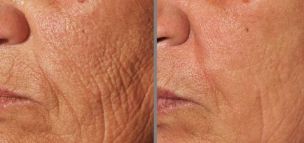
Facial facial repair is a type of laser surgery used to treat various skin problems. Perfectly removes pigmentation, acne scars, wrinkles, leaving the face young and fresh.
Because of its effectiveness, this cosmetic method is very popular among patients in clinics.
The difference between facial repair and laser resurfacing and other procedures
Some non-ablation lasers used in rejuvenation will not cause intense heating and will not harm the skin. The laser beam passes through the fractional lattice and divides into many small "rays" to heat the target tissue without destroying the target tissue. The laser energy creates tiny thermal "lumps" on the skin, which stimulates the growth of new healthy cells to replace damaged old cells.
Increasing the temperature will stimulate the production of collagen at the laser penetration point. This triggers the rejuvenation process that occurs from within, which affects all skin structures. Gentle effects and low trauma are especially important in facial repair, because the skin here is particularly thin and fragile.
After the procedure is completed, the face looks more beautiful and younger. Wrinkles, age spots, sagging, acne scars, enlarged pores and other defects disappear. Due to the point effect during the partial repair process and the device controls the penetration depth of the beam, the skin suffers less damage than grinding or chemical peeling.
The laser is so soft that most patients do not need anesthesia. In order to increase comfort, the cooling element is directly built into the device’s mobile phone. In case of allergies, use anesthetic gel.
Because the laser used for partial rejuvenation is gentle on the skin, a variety of treatments are required to obtain the desired results. The result is no less than other more traumatic anti-aging methods.
Indications and contraindications for some facial rejuvenation
- Age-related changes-This program can improve skin tone. Eliminates signs of aging-fine lines, wrinkles, age spots caused by lipofuscin pigmentation.
- Acne scars (post-acne)-When treating acne scars, this method is more effective than creams, masks, serums and other topical agents. The laser beam penetrates the skin to a depth of 1 mm and destroys the scar tissue. No cosmetic preparation can do this.
- Postoperative and traumatic scars-The laser removes or makes the marks of surgery, medical procedures, injuries and burns less obvious.
- Pigmented spots-Face rejuvenation, pigment accumulation caused by aging, sun exposure, hormone surge and drug destruction during pregnancy. During the operation, the dark lesions on the face gradually brightened and disappeared.
Due to its soft movements, this procedure has the least contraindications. These are purulent skin lesions, herpes, obvious inflammatory processes, malignant tumors, open wounds and abrasions, pregnancy. It is not recommended to perform partial skin rejuvenation at high temperature and feel uncomfortable.
Preparations and procedures for facial repair
One week before the first laser treatment, you need to stop using cosmetics containing retinoids (vitamin A derivatives). These substances increase the photosensitivity of the skin and may cause the appearance of age spots.
Before the operation, the specialist will treat the skin with products that clean the facial skin and increase the penetration of the laser beam. The eyes are protected by special glasses. The laser is aimed at skin problems-uneven texture, increased pigmentation, wrinkles and other imperfections.
After, a revival session will be performed, which lasts 20-50 minutes. The doctor ensures that all necessary areas are treated carefully. Laser irradiation will not be accompanied by pain and discomfort. It only feels warm and slight tingling sensation without causing discomfort. After the procedure is over, you can leave the clinic immediately.
What happens after facial rejuvenation
After the procedure is completed, you may feel slight redness and swelling on your face, but your skin will not become very red and scaly. Everything disappeared within a few days.
In order to obtain complete results, it is recommended to perform 3-5 treatments with an interval of 2-6 weeks. Then, the effect of laser rejuvenation will not be inferior to that obtained after mechanical resurfacing and other cosmetic methods.

The effect is not immediately visible and depends on existing issues. The pigmentation spots will be reduced in one or two treatments, and the scars and wrinkles can be removed in 3-5 visits. After the procedure, the skin condition will improve for another six to eight weeks.
In the first week after surgery, a mild cleanser and moisturizer should be applied to the skin twice a day. This will help prevent skin peeling and irritation. Washing with ice water has a good effect. Useful ascorbic acid-vitamin C intake
After being exposed to the laser, you need to protect your skin from UV rays, so you should use a moisturizing sunscreen for one month. You cannot sunbathe and use the solarium.
It is forbidden to use preparations on faces not recommended by beauticians. This can cause age spots, irritation, peeling and infection.
Partial facial repair can bring good results for up to two years. In order to maintain the effect, you need to use care agents and regularly perform other beauty steps to slow down aging.





















